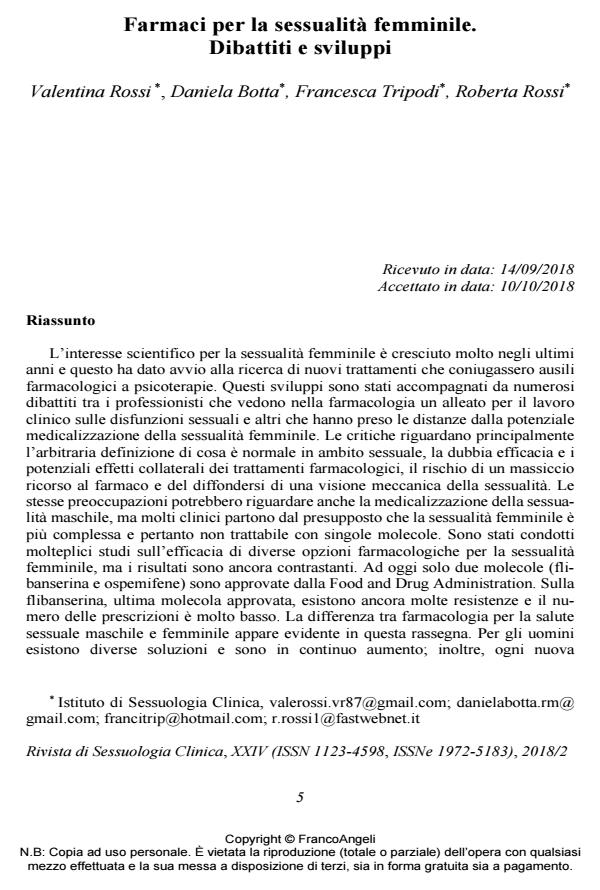Farmaci per la sessualità femminile. Dibattiti e sviluppi
Titolo Rivista RIVISTA DI SESSUOLOGIA CLINICA
Autori/Curatori Valentina Rossi, Daniela Botta, Francesca Tripodi, Roberta Rossi
Anno di pubblicazione 2018 Fascicolo 2018/2
Lingua Italiano Numero pagine 24 P. 5-28 Dimensione file 290 KB
DOI 10.3280/RSC2018-002001
Il DOI è il codice a barre della proprietà intellettuale: per saperne di più
clicca qui
Qui sotto puoi vedere in anteprima la prima pagina di questo articolo.
Se questo articolo ti interessa, lo puoi acquistare (e scaricare in formato pdf) seguendo le facili indicazioni per acquistare il download credit. Acquista Download Credits per scaricare questo Articolo in formato PDF

FrancoAngeli è membro della Publishers International Linking Association, Inc (PILA)associazione indipendente e non profit per facilitare (attraverso i servizi tecnologici implementati da CrossRef.org) l’accesso degli studiosi ai contenuti digitali nelle pubblicazioni professionali e scientifiche
L’interesse scientifico per la sessualità femminile è cresciuto molto negli ultimi anni e questo ha dato avvio alla ricerca di nuovi trattamenti che coniugassero ausili farmacologici a psicoterapie. Questi sviluppi sono stati accompagnati da numerosi dibattiti tra i professionisti che vedono nella farmacologia un alleato per il lavoro clinico sulle disfunzioni sessuali e altri che hanno preso le distanze dalla potenziale medicalizzazione della sessualità femminile. Le critiche riguardano principalmente l’arbitraria definizione di cosa è normale in ambito sessuale, la dubbia efficacia e i potenziali effetti collaterali dei trattamenti farmacologici, il rischio di un massiccio ricorso al farmaco e del diffondersi di una visione meccanica della sessualità. Le stesse preoccupazioni potrebbero riguardare anche la medicalizzazione della sessualità maschile, ma molti clinici partono dal presupposto che la sessualità femminile è più complessa e pertanto non trattabile con singole molecole. Sono stati condotti molteplici studi sull’efficacia di diverse opzioni farmacologiche per la sessualità femminile, ma i risultati sono ancora contrastanti. Ad oggi solo due molecole (flibanserina e ospemifene) sono approvate dalla Food and Drug Administration. Sulla flibanserina, ultima molecola approvata, esistono ancora molte resistenze e il numero delle prescrizioni è molto basso. La differenza tra farmacologia per la salute sessuale maschile e femminile appare evidente in questa rassegna. Per gli uomini esistono diverse soluzioni e sono in continuo aumento; inoltre, ogni nuova approvazione viene accolta positivamente nel panorama scientifico. Per le donne sembrano essere ancora molto presenti bias culturali e double standard che rischiano di ostacolare il lavoro sul benessere sessuale femminile. Quando si ha a che fare con le disfunzioni sessuali, siano esse maschili o femminili, è sempre fondamentale un approccio integrato che consideri tutte le componenti biopsicosociali coinvolte; avere a disposizione soluzioni farmacologiche anche per le donne potrebbe rivelar-si molto utile da un punto di vista clinico, non perdendo di vista le altre componen-ti implicate.
Parole chiave:Disfunzioni sessuali, terapia sessuale, sessualità femminile, medica-lizzazione, medicina sessuale.
Valentina Rossi, Daniela Botta, Francesca Tripodi, Roberta Rossi, Farmaci per la sessualità femminile. Dibattiti e sviluppi in "RIVISTA DI SESSUOLOGIA CLINICA" 2/2018, pp 5-28, DOI: 10.3280/RSC2018-002001